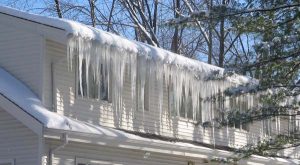Are You Ready For Ice Dam Season?

It’s winter in Minnesota, which means it’s also ice dam season. Ice dams are a serious headache for homeowners, especially in older homes where attic insulation is thin or nonexistent and air leaks are plentiful. Drive down any street in an old neighborhood or back road in rural Minnesota and you are likely to find a number of homes where gutters are overrun with icicles.
The number one cause of ice dams is not having the home properly insulated. Ice dams form when snow builds up on the roof, the temperatures are freezing and your home is losing heat. This snow melts and once it hits areas that are not losing heat, such as a soffit or gutter, it refreezes. The more snow, the more heat loss, and the longer the temperatures remain below freezing, the greater the likelihood an ice dam will happen. Preventing, rather than repairing will save hundreds or even thousands of dollars in roof and interior repairs.
Typically, the attic floor is insulated with batts. Insulation batts are the rolls of insulation, not the loose filling. The issue with the batts is they don’t do the best job of sealing between the heated space below and the unheated space above. We all know that heat rises, so it’s almost impossible to prevent heat from leaking into the attic through the attic stairs, light fixtures, ducts, and around chimneys and pipes.
Stairways, attic accesses, recessed light fixtures and any penetration into the attic from a heated living space should be insulated. When a home has a finished attic, baffles or tubes are installed between the ceiling insulation and underside of the roof to ensure sufficient cold air flow. Getting that small of a space insulated may be challenging and involve opening up the ceiling.
It is also important to insulate the roof slopes instead of just the attic floor. Insulation batts can be used for this job but they still do a poor job of preventing heat loss around their edges. The best solution is to use a material that has a good R-value but also effectively cuts off air infiltration. R-value is the capacity of an insulating material to resist heat flow. The higher the R-value, the greater the insulating power. There are two insulating products that dramatically reduce heat loss: blown-in cellulose and spray expanding foam products. They fill the framing bays completely and are so effective that it is not necessary to vent your roof, which avoids some of the problems that venting causes.
Water damage and freezing account for one of the largest shares of homeowner’s insurance claims. The most common form of ice dam damage is collapsed rain gutters, followed by cracked finishes on ceilings and walls, peeling paint, wet carpets and ruined wood floors. Equally destructive but less visible effects include wet insulation, rotting structure and mold formation.
The U.S. Department of Energy recommends adding insulation to an unheated attic because it has the greatest impact on energy in the house. Taking the steps to properly insulate your home will not only help avoid ice damming but can save you as much as 10- 50% on your heating and cooling bills.
One safety note: it might seem like a good idea to just physically remove the snow before it has had a chance to melt with a roof rake or a broom. Seems logical but in reality most homeowners can’t reach all areas of the roof. Additionally, it can be hazardous and you could potentially cause more damage to the shingles and gutters. If you are in the middle of suffering through an ice dam or fear a leak is going to happen, please be safe and hire a roofing company to remove the ice buildup. Keep safe and warm and keep those ice dams away!